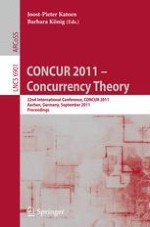2011 | Buch
CONCUR 2011 – Concurrency Theory
22nd International Conference, CONCUR 2011, Aachen, Germany, September 6-9, 2011. Proceedings
herausgegeben von: Joost-Pieter Katoen, Barbara König
Verlag: Springer Berlin Heidelberg
Buchreihe : Lecture Notes in Computer Science
